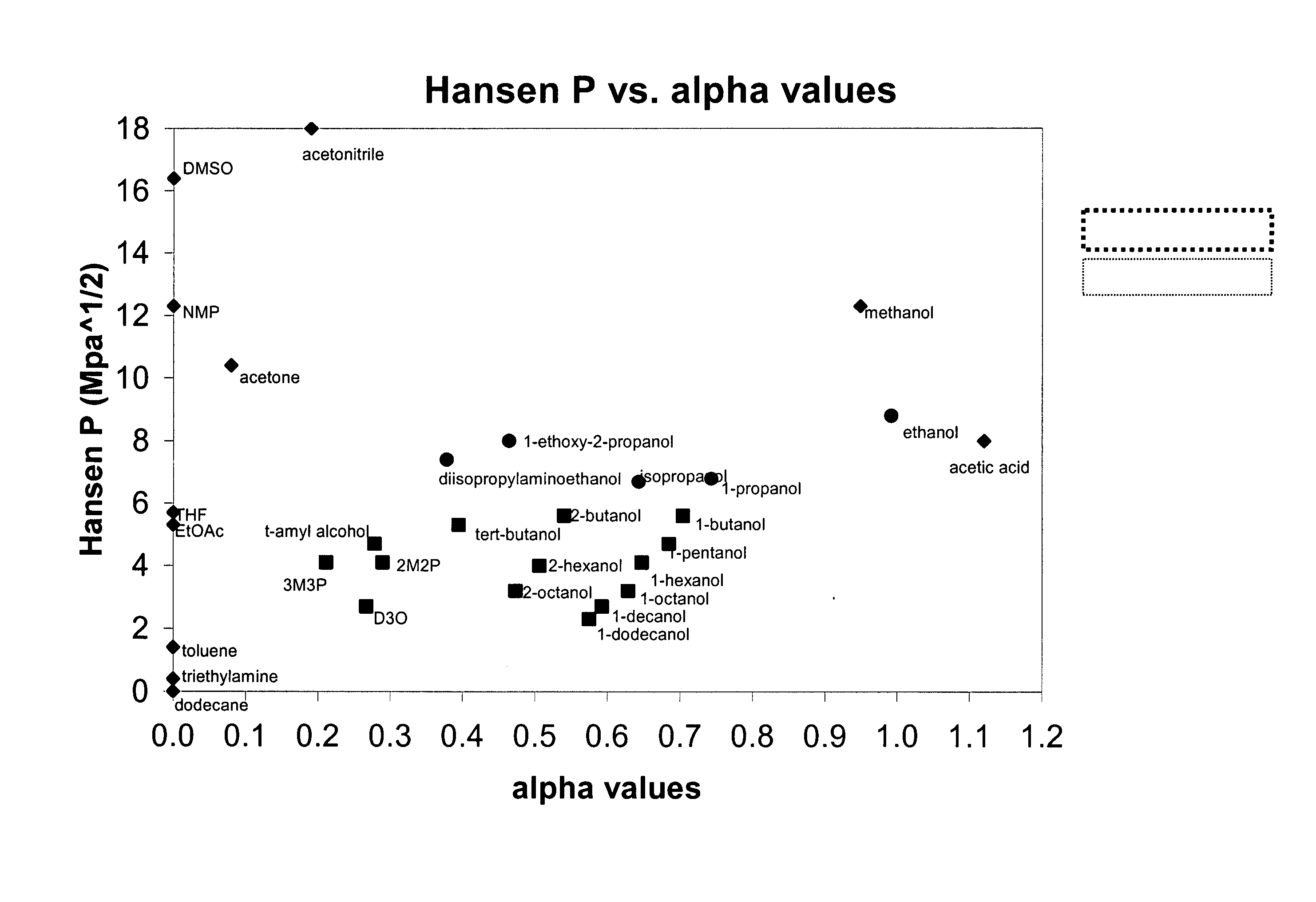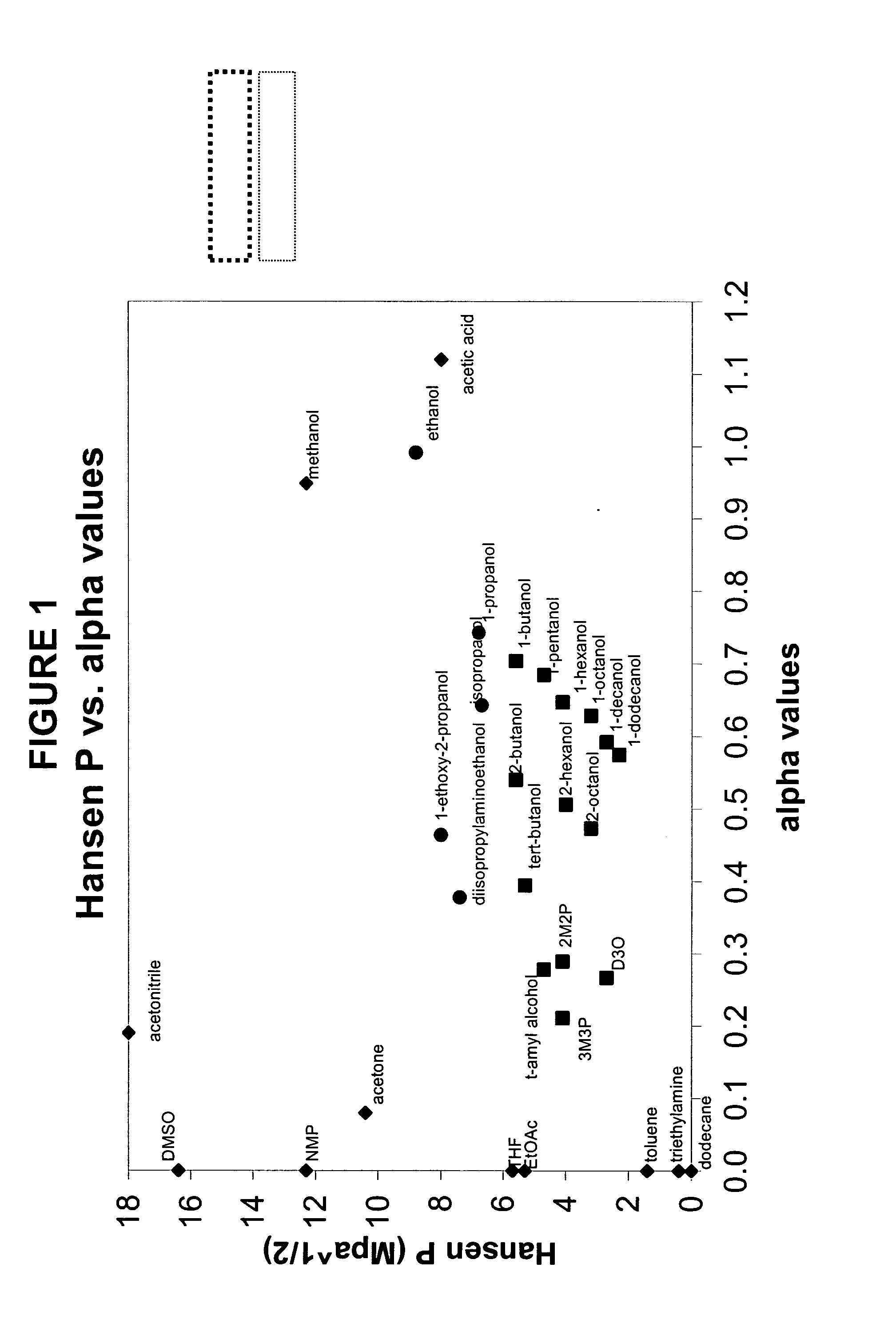Forming clear, wettable silicone hydrogel articles without surface treatments
a technology of silicone hydrogel and surface treatment, which is applied in the field of forming compatible compositions for forming molded articles, can solve the problems that the articles made from these components and diluents either did not form clear articles or were not sufficiently wettable to be used without coating, and many of these diluents did not form clear, so as to achieve the effect of increasing the thickness
- Summary
- Abstract
- Description
- Claims
- Application Information
AI Technical Summary
Benefits of technology
Problems solved by technology
Method used
Image
Examples
examples
[0044]Further examples of suitable silicone containing monomers are polysiloxanylalkyl(meth)acrylic monomers represented by the following formula:
wherein: R denotes H or lower alkyl; X denotes O or NR4; each R4 independently denotes hydrogen or methyl,[0045]each R1-R3 independently denotes a lower alkyl radical or a phenyl radical, and[0046]n is 1 or 3 to 10.
[0047]Examples of these polysiloxanylalkyl (meth)acrylic monomers include methacryloxypropyl tris(trimethylsiloxy) silane, pentamethyldisiloxanyl methylmethacrylate, and methyldi(trimethylsiloxy)methacryloxymethyl silane. Methacryloxypropyl tris(trimethylsiloxy)silane is the most preferred.
[0048]One preferred class of silicone containing components is a poly(organosiloxane) prepolymer represented by formula II:
wherein each A independently denotes an activated unsaturated group, such as an ester or amide of an acrylic or a methacrylic acid or an alkyl or aryl group (providing that at least one A comprises an activated unsaturated...
preparation 1
[0101]Macromer Prepared as described in US20030052424, Example 1
[0102]Zeonor Cyclo olefin thermoplastic polymer from Nippon Zeon Co., Ltd.
[0103]A three neck, 500 mL round bottom flask equipped with a magnetic stirrer, reflux condenser w / drying tube, and a thermocouple was charged with 5.0 g (0.054 mole) dry lithium methacrylate. Methacrylic acid (50.0 g, 0.584 mole) and 1.0 g p-methoxyphenol were added to the system, which was stirred while adding 200 g (about 0.20 mole) monoglycidoxypropyl polydimethylsiloxane (1000 MN) to the flask. The reaction mixture was heated to 90° C. The mixture was heated for 15 hours at the given temperature, allowed to cool to ambient conditions, and diluted with 250 mL of ethyl acetate.
[0104]The organics were washed two times with 250 mL of 0.5N aqueous sodium hydroxide. Once all the methacrylic acid present in the mixture was neutralized, separation of the two layers dramatically slowed down. The third and fourth washes were performed using an aqueous ...
example 1
[0126]The compounds listed in Table 2 below were screened for compatibility with mPDMS, DMA and PVP (K90) using the following procedure: mPDMS was added dropwise to a pre-weighed vial of a rapidly stirring solution of 1.67 g DMA, 0.33 g PVP and 2.0 g of the test diluent at room temperature until the resulting mix becomes hazy and does not become clear after stirring for several minutes. The mass of added mPDMS is determined and reported in Table 2.
[0127]The diluents were purchased from sources as follows:
[0128]Aldrich Chemicals: 1-decanol, 1-dodecanol, 1-octanol, 1-pentanol, 1-hexanol, decanoic acid, 2-hexanol, 2-octanol, 2-pentanol, 1-butanol, t-amyl alcohol, isopropanol, 2-(diisopropylamino)ethanol, tetrahydrofuran, acetone, diethylcarbonate, ethyl acetate, valeric acid, dipropyleneglycol methyl ether acetate, N,N-dimethylpropionamide, acetonitrile, 2-methyl-2,4-pentanediol, N-t-butylformamide, ethyl (S) lactate, N-ethylacetamide, solketal, N-methylpropionamide, dimethylsulfoxide,...
PUM
| Property | Measurement | Unit |
|---|---|---|
| weight % | aaaaa | aaaaa |
| molecular weight | aaaaa | aaaaa |
| molecular weight | aaaaa | aaaaa |
Abstract
Description
Claims
Application Information
 Login to View More
Login to View More - R&D
- Intellectual Property
- Life Sciences
- Materials
- Tech Scout
- Unparalleled Data Quality
- Higher Quality Content
- 60% Fewer Hallucinations
Browse by: Latest US Patents, China's latest patents, Technical Efficacy Thesaurus, Application Domain, Technology Topic, Popular Technical Reports.
© 2025 PatSnap. All rights reserved.Legal|Privacy policy|Modern Slavery Act Transparency Statement|Sitemap|About US| Contact US: help@patsnap.com



